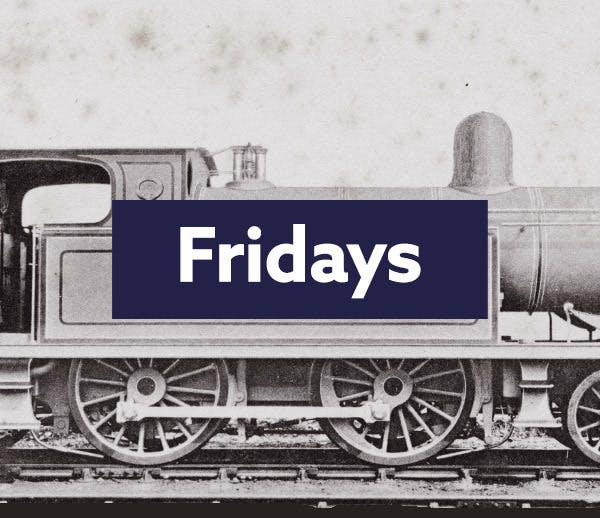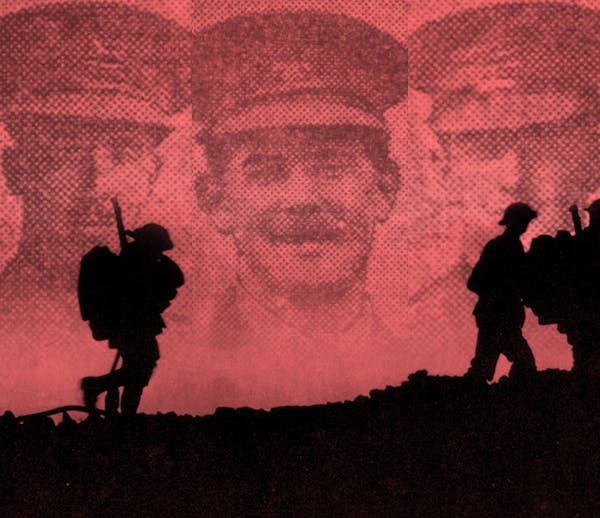This is what it was like to be in London on VE Day in 1945
10+ minute read
By The Findmypast Team | May 1, 2025
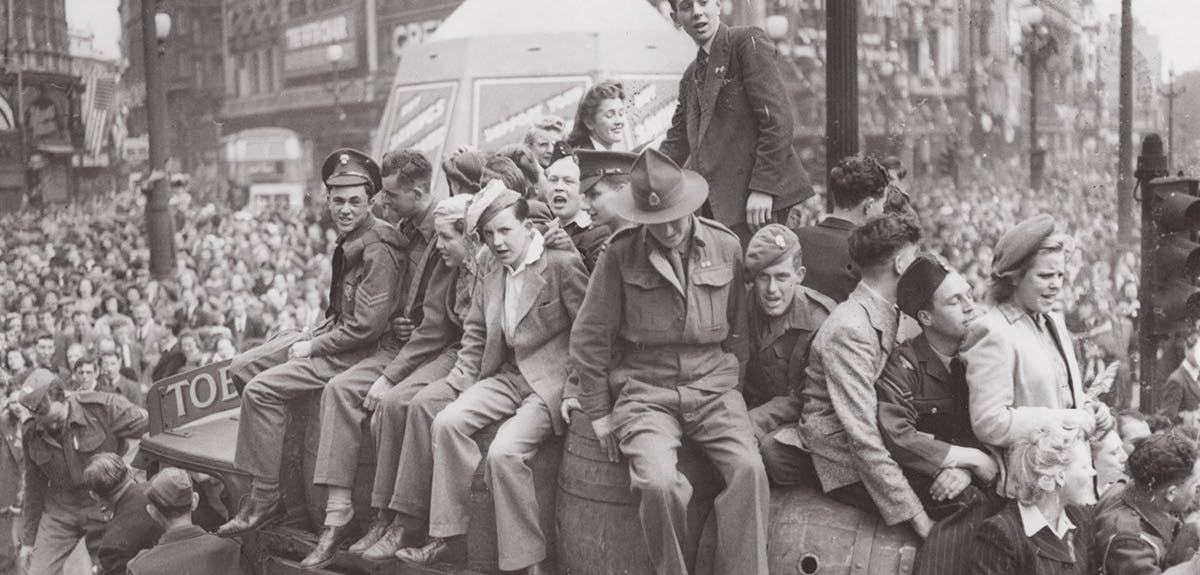
Delve deeper into Victory in Europe Day stories with this amazing firsthand account, written by an American Sergeant who was in London at the time.
This uplifting family story was shared by Findmypast Community member Patricia Barry Coleman. Her father, Thomas Barry was in London on Victory in Europe Day, May 8, 1945.
Find family heroes and more
Enter a few details to see records from your past at your fingertips
When Sergeant Thomas Barry of the US Air Force traveled to London in May 1945, he had no idea he would soon find himself in the middle of the biggest party the capital had ever seen. Born in Norfolk, Virginia in 1914, Thomas shipped off to Europe in 1944 to serve in Northern France, the Ardennes, Rhineland, and Central Europe as a Technical Sergeant and Glider Pilot with the 94th US Air Depot Group.
With the war still raging on the continent, Thomas and his pal Rich Richardson requested leave and flew to London to see the sights and unwind. Unbeknownst to them, Victory in Europe was about to be declared and the city’s bomb-battered inhabitants would soon take to the streets in record numbers to celebrate their collective relief following half a decade of bitter struggle.
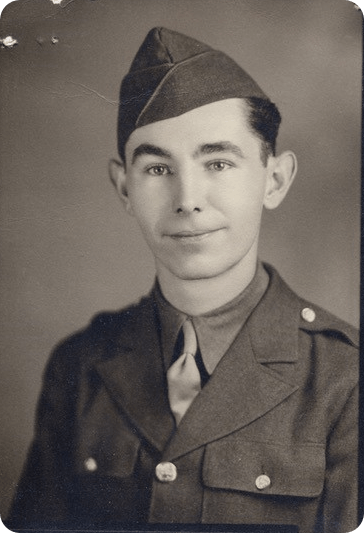
Sergeant Thomas Barry, 94th US Air Depot Group.
Armed with his handheld camera, Thomas flitted between military clubs before heading out to join the throngs of revellers.
As well as taking candid photos that perfectly capture the atmosphere of that joyous day, Thomas recounted his experiences in a letter to his beloved wife Marie, whom he had married a year before shipping out.
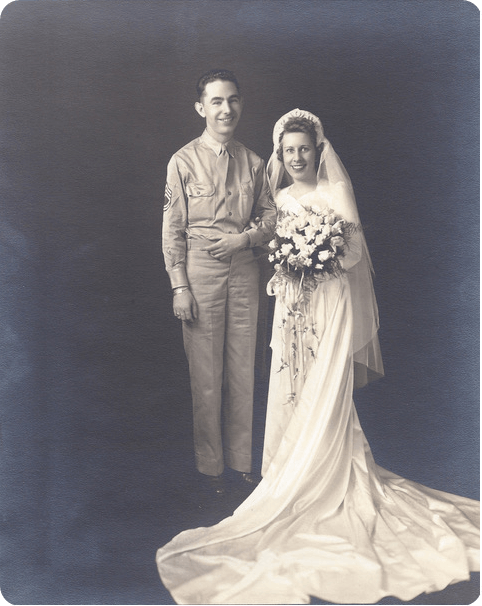
Thomas and Marie on their wedding day, 11 May 1944.
His photos and letter, which describes iconic moments such as Churchill’s parade and the King’s speech, was unearthed by his daughter, Patricia Coleman, a retired Ph.D. Research Chemist from Minnesota. With Patricia’s help, Findmypast is incredibly proud to share this wonderful snapshot of one of the greatest celebrations in British history. Thomas' letter is written as follows;
Somewhere in East England,
May 10, 1945
Well, I spent VE Day in London on pass, and have never seen such a crowd of joyful people in my life. One couldn’t help but be happy at a time like that.
When my friend, Sgt Richardson, and I decided to take a pass over May 5, we did not know that it was going to be VE Day – until the news came over the radio late Monday evening. Very fortunately, a plane happened to be going near London Tuesday morning so we got a ride on it, and we were lucky to get a bus from the airport down there about five minutes after we taxied the field. We got to London about 11.30 and the streets were thronged with people then. We took an underground train from Marble Arch station to Piccadilly and walked from there to Charring Cross Road, to the Eagle Club, where we had a snack (meat pie and coffee), checked our bags and went in search of a place to stay.
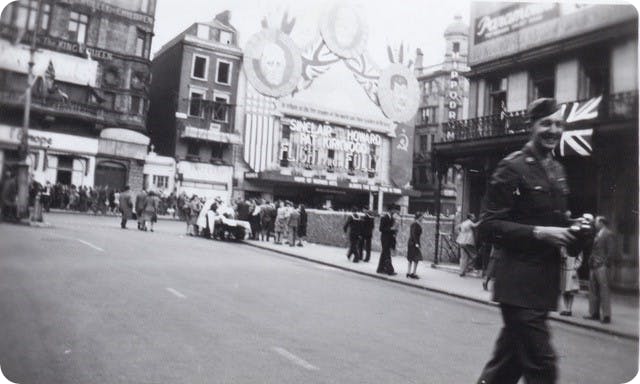
Thomas' pal, Rich Richardson, smiling in front of an ice cream stand at the corner of Leicester Square. Note the prominent pictures of Roosevelt, Churchill and Stalin mounted on a building in the background.
The letter continues;
We went back to the Rainbow Club, the main ARC club in London, where we were told to go to the Hans Crescent ARC club for a room. The Hans Crescent is on Hans Crescent, a short street running from Brompton Road to Sloane Street, near Harrods’s, the big department store, and not many blocks from the famous Brompton Oratory, where Cardinal Newman used to be stationed. So we took the underground again from Piccadilly to Knightsbridge, getting off at Sloane Street, and went to the Club. We checked in and were assigned beds “A” and “B” in the Annex to the Club in room 415, a small room containing two double-locker bunks on the fourth floor (that’s the fifth floor in the States – over here, as well as on the continent, the first floor of a building is called the “ground floor”, and the second floor as the “first”, etc.). Then we went down to the cafeteria and had a fillet of fish, potatoes, rolls, buns and coffee for lunch (it cost 1s/3d – roughly about 25 cents). Then we went back to the underground and took a train back to the Eagle Club. Incidentally, the fare on the Underground is 2d. – Roughly 5 cents from one place to the other; of course, the fare is increased for longer trips. After sitting around the Eagle Club for a while, we took our raincoats (just in case of rain) and cameras and set out about 2:0 P.M. for Parliament Square to listen to the Prime Minister's speech – the official announcement of the end of the war in Europe – which was to be given at 3 o’clock.
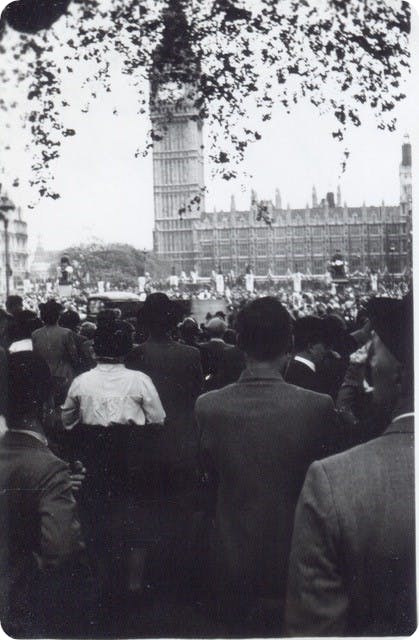
Thomas' photos show Parliament Square was packed by 2.30 pm, as joyous crowds eagerly awaited Winston Churchill's address.
We walked from the club to Coventry Street, where all the theatres are, and then Piccadilly Circus (which, by the way, is a circle with a statue of Eros, the God of Love, in the center – but I’ve never seen the statue for it has been covered up to protect it from the bombing and blitz), to Lower Regent Street or Haymarket, and so on to St. James’ Park, to Birdcage Walk and Parliament Square. The Square is a sort of park with a number of statues of former Prime Ministers, and in a smaller section, all alone, stands a copy of the famous statue of Lincoln at Springfield – showing Lincoln standing, holding a paper in his hands, and a curved chair just behind him; this Statue of Lincoln faces Westminster Abbey, which is on the west side of the square are large buildings, but I don’t know what they are. We arrived in the Square about 2:15 and stood about a hundred yards from Lincoln’s statue. The place was overflowing with people, men, women, children, civilians and members of the armed forces, British, American, French, Poles, Norwegians, Belgians, etc. – everyone who could be was there. We stood facing Big Ben, watching the crowd and occasionally glancing at the clock to watch the minutes go by. We took a number of pictures of the crowd while we were waiting. One British civilian laughingly pointed out to a sign – or poster rather – on an air raid shelter which read in big letters “The Surface Shelters Can Take It” – and then made a remark about the crowd on top of the air raid shelters being a pretty good proof of the notice; and it was, for almost every available inch of the roof was occupied by someone. Other people were on the roofs of adjacent buildings, all over the statues, clinging to the trees and the lampposts and street signs. Rich and I thought the picture of the day would be Big Ben with its hands pointed to the four of 3:00, so we kept watching, for that moment, and as the chimes began to ring just before the stroke of the three we snapped a picture. As the last stroke of three rang out it was picked up by the P.A. system which was installed in the square, with loudspeakers in the trees and on the lampposts, and the crowd almost when wild with cheers.
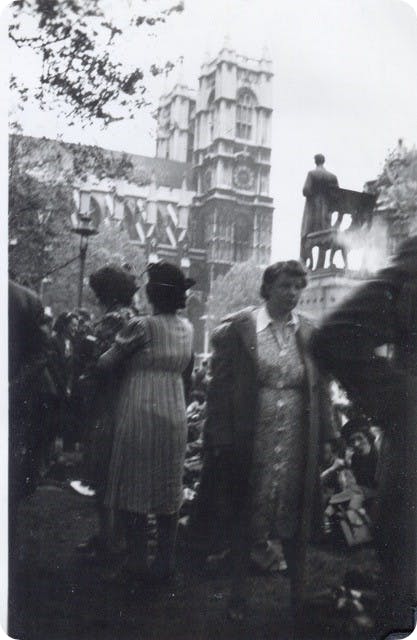
Westminster Abbey & the Statue of Lincoln that Thomas refers to in his letter.
The bugle call “ceasefire” was sounded, then the Speaker of the House of Commons introduced Mr. Churchill, who gave a very fine talk, sprinkled here and there with great cheering from the crowd standing in the square outside the house. He ended it with the words “God save the King!” – Then we snapped to attention as the British National anthem was played, and the crowd joined in the singing with hearts that were joyful and thankful after nearly 5 and a half years of war. What a crowd there was – they filled the square overflowing, stretched past Parliament over Westminster Bridge to the south, for blocks on Whitehall to the east and west, and filled Birdcage Walk and Victoria to the North. After Mr. Churchill’s speech everyone knew – somehow or other- that he and both Houses of Parliament would go in procession from the House to St. Margaret’s Church, adjoining Westminster Abbey, and opposite the House itself, to offer thanksgiving to God for peace in Europe, so we – like all others – waited and waited until finally, they came. I forgot to tell you – after Prime Minister’s talk, the chimes of St. Margaret’s began ringing and continuing to ring until the procession came into sight. About 4:00 o’clock it came by – led by six policemen on horseback, then the officers of the House, the speaker in his wig and gold roe, and then one saw a short fat man with bald head shining – the “greatest man in England”, as the newspapers are calling him – that was Winston Churchill. While we were waiting, a small boy in the crowd near us began crying and someone asked his mother what was the matter with him; she said: “He wants to see Mr. Churchill” – but I doubt very much if he did, for all I saw was the P.M.’s head, and the back of his head at that!
After the procession had passed and the crowd began to disperse, we went over the Westminster Bridge and sat down on the railing to rest for a while. We were hot and tired but still enjoying ourselves. (In fact, I’m still very tired, but wouldn’t have missed those two days for the world). After 5:00 o’clock we got up enough nerve to stand up and walk again, and walked down the Victorian Embankment past Scotland Yard, there to Whitehall and stopped for a few minutes at Downing Street, where another huge crowd had gathered to see “Winnie” again. Then we went back up Whitehall to Trafalgar Square, through a crowd like Times Square, New York on New Year’s Eve, to the Strand, behind St Martin’s in the Fields to Charring Cross Rd., and the Eagle club again. By this time we felt like a couple of sardines in olive oil, so we sank down on a sofa and rested for a while; then got our bags out of the check room and took off to get the Underground back to the Han’s Crescent Club for a shower and a bit of supper – for we “had” to get back down to Buckingham Palace by 9:00 to hear the King, and perhaps see him too! Well, the last straw – the statinos were so packed that we decided to start walking on from Piccadilly Circus, down Piccadilly to Green Park, where we sat down to rest for a while in the grass under a tree – then on again past Hyde Park Corner to Knightsbridge Road, and so on to the club. Hyde Park corner, you know, is the place where anyone can get on a soapbox and have an audience, just as in Union Square N.Y. We were extremely tired by this time and hot as blazes, as we were wearing uniform with a coat also and had been carrying our field bags slung over our shoulders. We washed up a bit but didn’t have time to shower – so we ate supper and took off again, still walking, but this time the distance wasn’t too great – from Knightsbridge to Constitution Avenue and we were outside the Palace at about 7.45 P.M. At that time, the crowd was enormous and every vantage point, even the huge statue of Queen Victoria in front of the Palace was filled with people; in fact, some of them fell off their seats on the statuary group into the pools of water at the bottom of the statue.
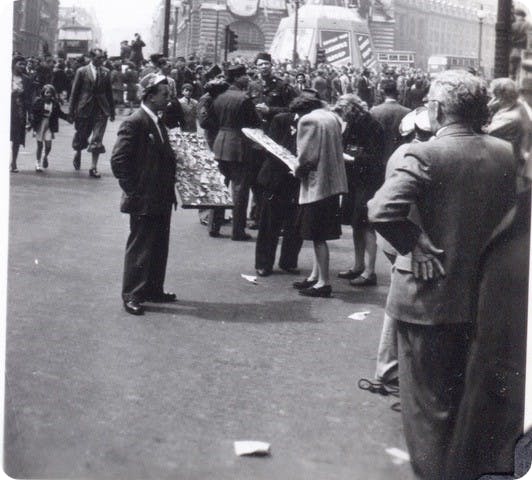
Another of Thomas' photos show revellers gathering in Piccadilly Circus.
Every ten or fifteen minutes someone would start cheering, then everyone would rush up to the fence to see if perhaps the King had appeared on the balcony; some men were even climbing up the iron fence around the Palace grounds to get a glimpse of what was happening – but of course, the King didn’t appear until after he had spoken to the Empire over the radio. About 8.30 pm (That’s 2.30 pm Eastern War Time), the sounds of the chimes from one of the churches – probably St. Margaret’s – came over the amplifier set up outside the Palace; then the announcer began: “This is London-calling the men and women of the Empire all over the world”, or somewhat similar words. Then he spoke of each of the armed forces – the Royal Navy, The Royal Army, the Royal Air Force, the armies, navies and air forces of Canada, Australia, New Zealand, the women’s organizations (WRENS, ATS, WRAF and their equivalents in various parts of the empire), the medical corps, doctors and nurses, civilians workers – women – and, of course, the Merchant Navy, and told how a representative of each had come to salute the King. As he referred to each, a representative of that branch or those branches (for example, a nurse spoke for all the women’s organizations, civil, naval and military) – would make a speech to the King. I recall a civilian mother from London spoke of how she had tried to keep her family together as much as possible and had tried to keep a room “for the boys” to come home to despite the bombings and the Blitz, and how all the people of the country had looked up to the Royal Family, who had shared with them the dangers of the London Blitz and the V-bombs, as the model of all families of the Empire. Each speech ended with these or similar words: “Your Majesty, the Royal Navy (RA, RAF, or whatever branch it was) salutes you.”

Thomas' camera captured servicemen and civilians dancing near Coventry Street and Leicester Square.
At just exactly 9:00 P.M., British double summertime, they played the British National anthem, then the announcer said: “His Majesty, King George the Sixth”, and after about a minute’s pause, King George spoke. I don’t recall exactly everything he said, but you have probably read it in the papers anyhow, but I remember he said that they still have the Japanese to defeat before there would be any final victory. He spoke for about a half-hour and at every opportunity, whenever he paused, the crowd cheered wildly. Then the P.A. system was turned off at the end of the broadcast, and everyone was jabbering at once – with occasional cheers ringing out. A group of youngsters started crying; “We want the King” as you’d expect people to do at a football game, and to my surprise, the crowd took up the cry. Finally, about 10:00 o’clock the door leading to the balcony was thrown open amid loud, wild cheering from nearly everyone. The railing of the balcony was covered with a sort of red velvet canopy trimmed with gold fringe; in fact, it had been so covered all day, I suppose. The eyes of all were straining for the first glimpse of their majesties. Shortly after the door was opened, HM Queen Elizabeth came out on the balcony, followed by the King, and the two princesses. The Queen was lovely in a white gown with a small white hat or headdress; the King wore his naval uniform, as commander in chief of the Royal Navy, which is the ranking service; Princess Elizabeth wore the uniform of a subaltern in the Army Territorial Services (ATS), which she had joined a month or so ago; and Princess Margaret wore a pale blue gown. The Royal Family stood on the balcony for about 15 or 20 minutes, waving occasionally in response to the cheers for the crowd of about 100,000 people. It was quite an occasion.
After the King and Queen and princesses turned back into the Palace, we started out to go down the Mall (Pall Mall), but the crowd was so thick that we turned back and out the South Gate to Birdcage Walk. As we came within four blocks of the Thames, they began turning on the floodlights. On the face of Big Ben, so we stopped there to look at it a while, then proceeded around the edge of St James’ Park back to the Mall, and then Admiralty Arch, which was also floodlit Nelson’s Statue, atop his column in Trafalgar Square, was bathed in bright Lights, as were a number of buildings around the square. We went back to the Eagle Club and had a snack and sat talking with the Red Cross women until nearly midnight. We waited there until about ten minutes after midnight, to celebrate the actual time that the firing on all fronts in Europe was to cease, then walked on back across to the West End to the Hans Crescent Club, and got to bed about 1.20 A.M., Wednesday Morning.
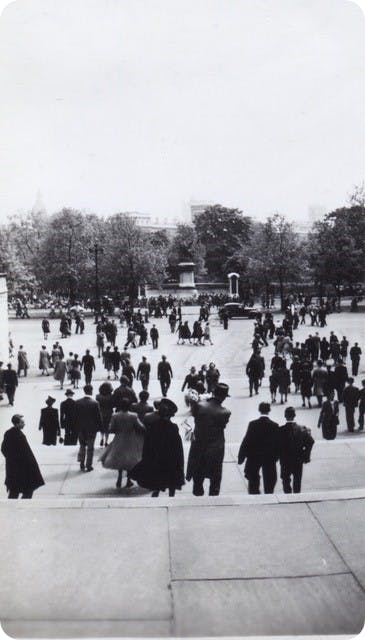
Thomas captured crowds heading towards Buckingham Palace for the King's Speech and the Royal Family's appearance on VE Day.
We arose Wednesday about 11:00 and went over the Eagle Club again. Past afternoon we had just finished some waffles and coffee at the snack bar when an RAF sergeant sitting at a table near one of the windows yelled out “here they come!” or something of the sort and everyone began rushing to the windows just in time to see the King and Queen ride past in an open sedan. The King was in naval uniform again, and the queen in a pale blue hat and gown. As the car came abreast of the Eagle Club, Her Majesty looked up at the window, smiled and waved to us; and of course, we nearly broke our backs leaning out of the window to see them and wave back.
Wednesday all the buildings in London were draped with flags of Great Britain, the USA, the USSR, France, Belgium, Norway, China etc. – reminding me of the flags flown at half-mast on April 13 all over the city and the suburbs – Britain and American flags – in mourning for President Roosevelt. The London Theatre, perhaps the largest movie theatre in London, has a very lovely display of the flags of the Big Four. Warner Brothers Theatre had a huge painting covering the entire front of the building, a massive “V”, with the picture of Churchill in the top center surrounded by British Flags, Roosevelt and the American flag at the left and Stalin and the Soviet flag at the bottom right. The joy of the red, white, and blue caps of the same colors, badges like the Warner Brothers’ vast picture of their theatre, the tricolored Rosettes, etc. Bobbies in their blue uniforms and odd-looking hats, and American M.Ps were standing in the center of the main streets watching the crowds go by. At night there were searchlights over the city, fireworks, gun salutes. I noticed one British woman about 60 years old in the middle of Piccadilly Circus holding up her skirt while she sang and danced. Men and women, in uniform and civilian clothes, were singing “Tipperary”, “Roll out the Barrels”, “Yankee Doodle Dandy”, and lots of similar songs as they danced up and down the main streets. One little girl of about 3 looked very cute in a white silk dress, the red, white and blue trimmings and blue shoes. Everyone was wearing the colors (the red, white and blue, which is as common to the British and French nations as it is to us), and many had on the tricolored caps – the American G.I’s. People of all nations had joined with Londoners in celebrating the victory over Germany. It was Mardi Gras crowd, full of joy and revelry, but there was no such thing as rowdyism. Well, anyhow, I wouldn’t have wanted to miss VE Day in London for anything except being home – now the questions is – when will the war really be over for us? Soon I hope, so the people in America can feel the excitement that Britain has felt on VE Day.
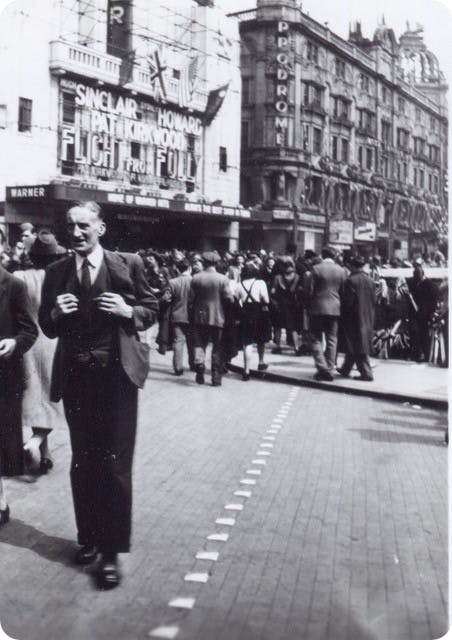
Thomas took a picture of Warner Bros. Theatre in Coventry Square, London. It's just as he described in his letter.
After the war, Thomas returned home to his beloved Marie and worked for the Veterans Administration before embarking on a career with the Richmond, Fredericksburg and Potomac Railroad (RF&P) as an accountant. He passed away in 1984 followed, by Marie in 2013.
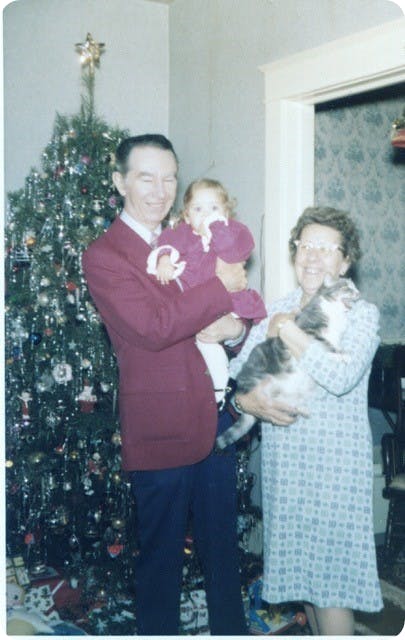
Thomas, Marie and their granddaughter in 1976.
Delve deeper into the highs and lows of your family story
Findmypast would like to offer our sincerest thanks to Patricia Coleman for sharing these precious heirlooms and enabling us to tell this story. Do you have a similar tale to tell? Reach out to us on social media using #WhereWillYourPastTakeYou? for a chance to be featured.


